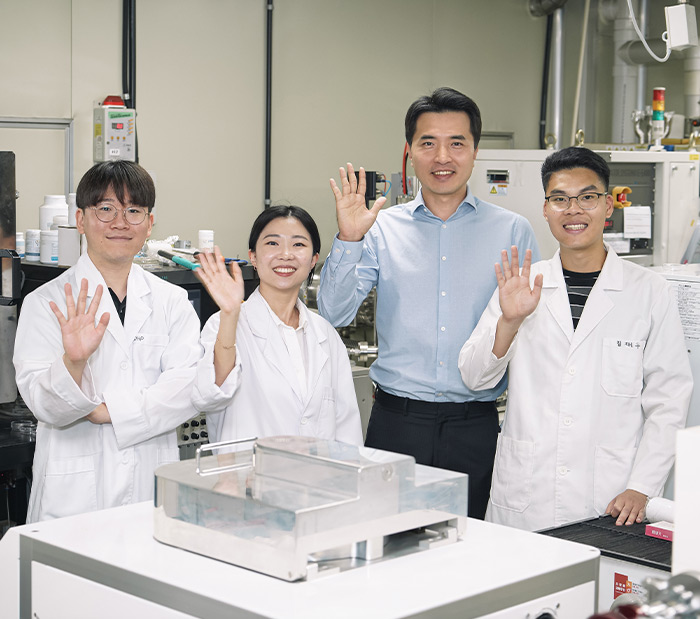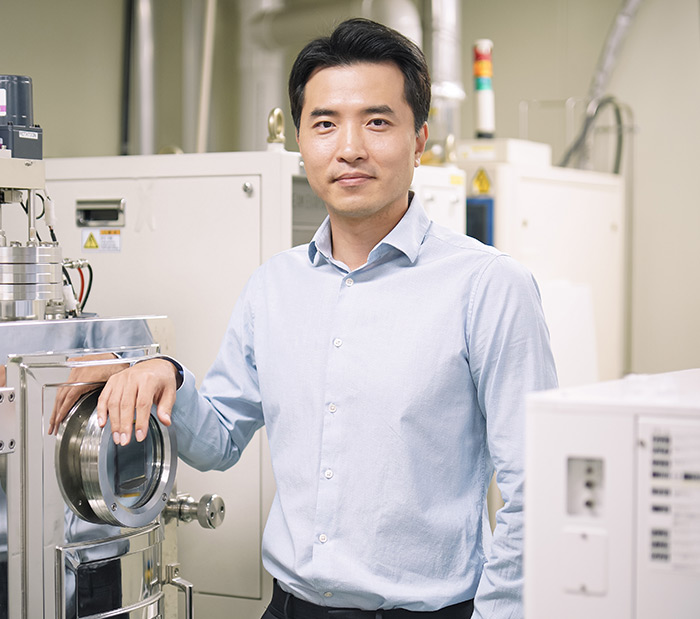Research Stories
Prof. Woo Jong Yu's research team implements an artificial brain neural circuit that self-learns like the human brain
Development of Artificial Brain Cells, Synapses, and Neural Network Circuits that Operates Similarly to the Human Brain to Achieve Active (Unsupervised) Learning Artificial Intelligence
Professor Woo Jong Yu, Department of Electronic and Electrical Engineering
Electronic and Electrical Engineering
Prof.
YU, WOOJONG
Sungkyunkwan University's Department of Electrical Engineering Professor Woo Jong Yu and Department of Energy Sciences Professor Young Hee Lee's joint research team developed an artificial brain cell device that operates equally with human brain cells through collaboration with Senior Researcher Eui Yeon Won of Hyundai Motor Company. A self-learning artificial brain neural network circuit mimicking the neural network structure was implemented.
Current artificial intelligence algorithms use hundreds of large-capacity supercomputers and consume enormous amounts of electrical energy. On the other hand, the human brain implements intelligence using very little energy in a small size of about two fists. If an artificial brain that operates on the same principle as the human brain is created, artificial intelligence that operates on a small smartphone will be possible. In fact, ‘neuromorphic systems’ that mimic the human brain are being actively researched, and ‘Memristor’, a new concept memory that can precisely imitate the human brain, is attracting attention.
*Neuromorphic Systems: Computers designed in the structure of Neuromorphic systems that imitate the human brain. Conventional computers follow the von Neumann architecture, which is fast for sequential calculations like mathematical operations but not suitable for the parallel calculations required for artificial intelligence. For instance, AlphaGo achieved parallel computation by connecting thousands of computers in a von Neumann structure, leading to high power consumption. In contrast, neuromorphic systems are designed to perform parallel computations efficiently by connecting thousands of small CPUs and memory units, similar to human brain cells, resulting in high AI performance with minimal power consumption.
*Memristor: A portmanteau of "memory" and "resistor." Unlike regular resistors, memristors store memory by changing resistance values in response to external input and maintain these changes for a certain period. Unlike conventional memory components that remember only 0/1 states, memristors can remember over 100 states. This property enables a single memristor to replace multiple memory units, significantly reducing the size and power consumption of artificial neural networks.
Memristor is a new device that stores memories by changing the resistance value, and is used to mimic ‘synapse’, a connection between brain cells and a memory storage organ. In 2016, Professor Yu's research team first developed a flash memory-based 'two-electrode-floating gate-memristor' with excellent reliability, and used it to simulate the memory storage method of synapses (Nature Commun. Doi:10.1038/ncomms12725 ). However, in order to fully implement the human brain function, a brain cell mimic device that performs calculation is additionally required.
*Flash Memory: A non-volatile memory that retains stored information even when power is lost. It's widely used in portable devices like smartphones and digital cameras due to its high reliability.
In this study, the research team developed 'multi-electrode-floating gate-memristor' for the first time and succeeded in mimicking the operation of brain cells (neurons) (Figure 1). Electrical signals are exchanged between brain cells connected in various ways. At this time, the brain cells accumulate the electrical signals received in the body (membrane potential) (leakage summation function), and when a certain amount of electrical signals are accumulated, a new electrical signal is generated (ignition). function). The research team first implemented artificial brain cells that perfectly follow the movements of these brain cells by using 'multi-electrode-floating gate-memristor'. The potential of the floating gate of 'multi-electrode-floating gate-memristor' simulated the membrane potential of brain cells to simulate the leaky-integrate function, and measured the amount of accumulation of electrical signals through a comparator connected in a sequential circuit and The electrical signal ignition function (fire) was simulated. 'Multi-electrode-floating gate-memristor' is a structure with several electrodes (multi-electrode), and by using this, it was possible to simulate the multi-pronged connection between brain cells.
The research team next connected several 'multiple electrodes-floating gates-memristors' to each other to simulate self (unsupervised) learning of the connection structure between human brain cells (Figure 2). To this end, 'multiple electrodes-floating gates' An artificial brain neural network that connects 12 ‘gate-memristor’-based artificial brain cells (computing elements) (9 inputs, 3 outputs) with 27 ‘floating gate-memristor (2016)’ artificial synapses (memory elements). circuit was constructed. The artificial brain neural network circuit constructed in this way learned the classification of direction lines, which is the primary visual information processing function (vision cortex 1) of the human brain, on its own (unsupervised) without human intervention, and with the learned intelligence, perfectly distinguished the direction of various direction lines. gave In addition, in the learning simulation of human handwritten digit data (MNIST dataset), it self-learned (unsupervised) without human intervention and showed a high accuracy of 83%.
Professor Woo Jong Yu said, “This research is significant in that it has realized active artificial intelligence that learns on its own (unsupervised) like humans through the development of artificial brain cells, synapses, and artificial brain neural network circuits that operate in perfect harmony with the human brain. “Unlike conventional supervised learning, which is confined within the boundaries of human knowledge, unsupervised learning learns on its own through data, so it is possible to implement creative artificial intelligence that can derive new knowledge that goes beyond the level of human knowledge.”
*The results of this research were published in Nature Communications (IF = 17.694), a world-class science and technology journal, on May 27, and the Devices section of the 'Editors' Highlights page' selects the best papers among the latest was introduced on 14 June.
* Multi-neuron connection using multi-terminal floating–gate memristor for unsupervised learning (저널: Nature Communications, DOI: https://doi.org/10.1038/s41467-023-38667-3, Editors’ Highlights page - Devices: https://www.nature.com/collections/bjiiabbacg)
▲ Figure 1. [Left] Connection structure between brain cells in the human brain. [Right] Artificial brain cell structure using ‘multi-terminal floating gate memristor’ that mimics human brain cell and connection structure.
▲ Figure 2. [Upper left] Classification of direction lines, the primary visual information processing function (visure cortex 1) of the brain [Right] 'Artificial brain neural network circuit that connects 12 brain cell (computation) elements and 27 synapse (memory) elements'


